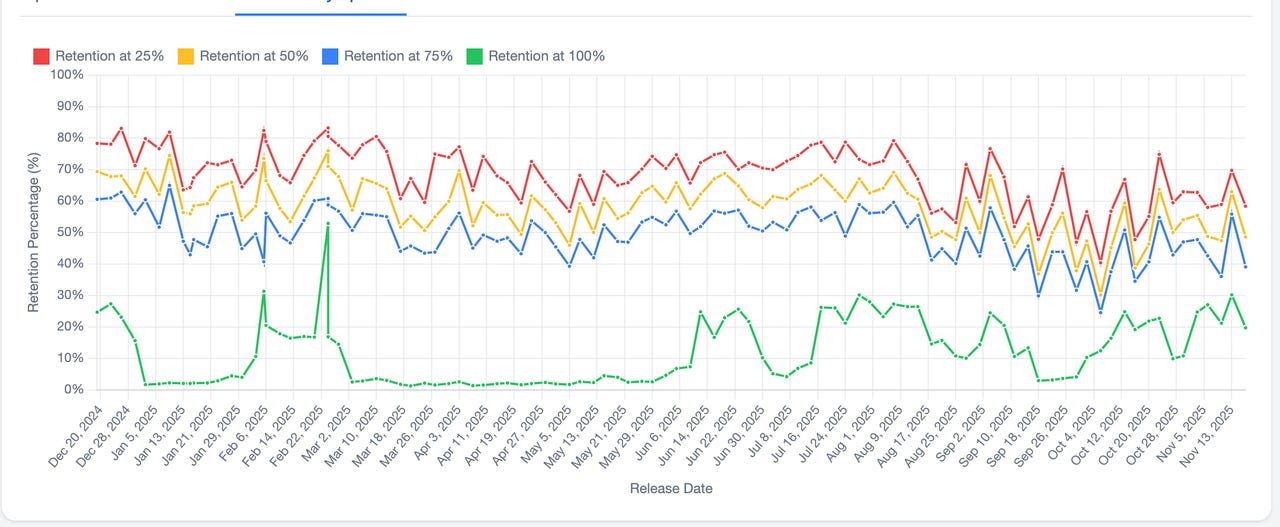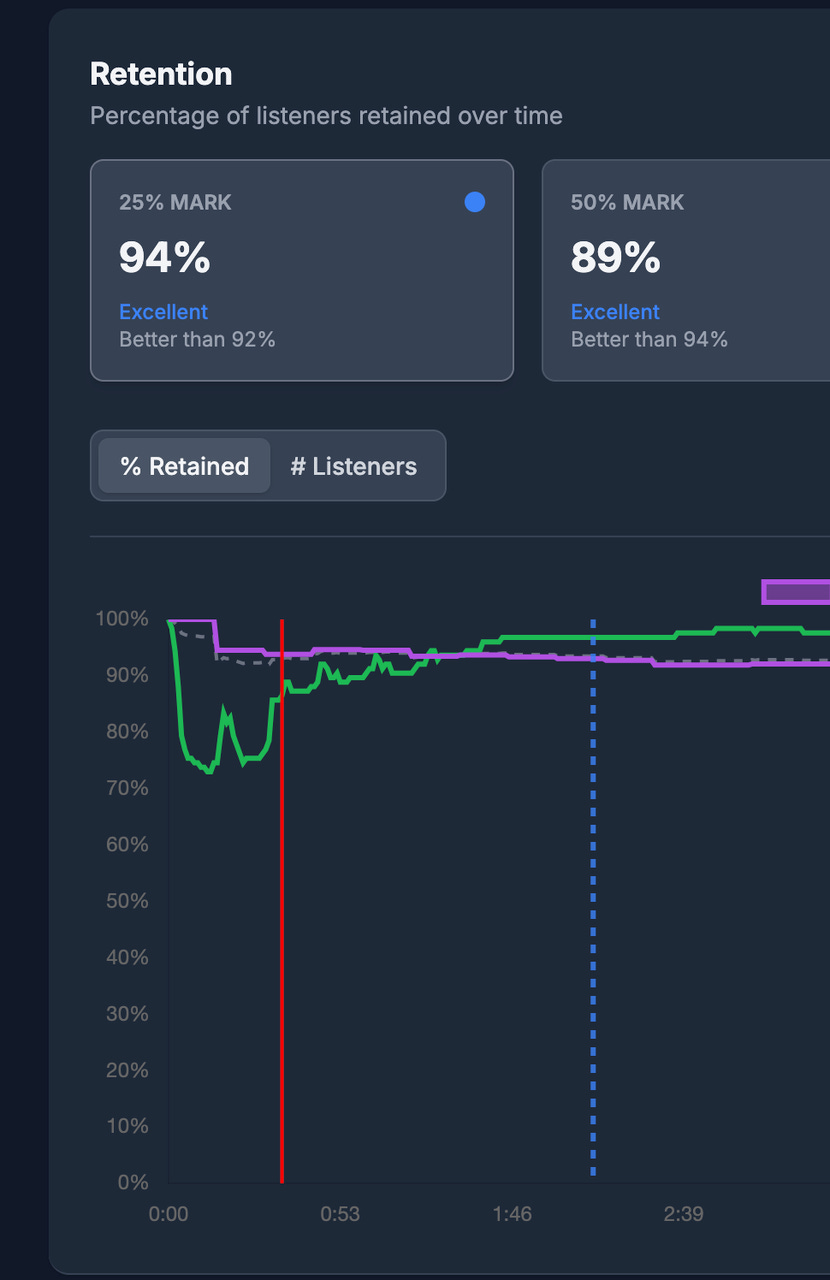The Analytics Founder Who Might Fix Podcast Data
Podcast analytics are entering their punk-rock era, and George Lejnine might be the builder leading the rebellion.
Why This Matters Now
If you’ve felt like podcast analytics are stuck in 2016, you’re not wrong. In fact, the rise in new analytics tools has been something we’ve covered extensively since starting this publication, as we feel it is one of the most critical breakthroughs the industry needs to make in the near term in order to unlock the kind of scale the industry is poised for.
Meanwhile, downloads still dominate reporting. Major platforms guard “their” (your) data like they’re nuclear launch codes. And every year, more all-in-one tools promise to “fix everything” while mostly adding more dashboards you don’t use in practice but look pretty because they’re “busy’.
But something’s changing.
Talking with George Lejnine, founder of PodAnalyst, felt like catching the industry in the middle of a shift from vanity metrics to actionable intelligence, from bloated mega-apps to sharpshooter tooling, and from faith-based analytics to real listener performance.
George, a lifelong software engineer (interestingly NOT a self described “podcast professional) who’s built audio tech for over a decade, is not chasing the “Swiss Army knife” trend. He’s doing the opposite: cutting through the noise with the kind of precision, clarity, and specificity that podcasters (and advertisers) have needed for years.
1. The Context: Podcast Analytics Are Having Their Identity Crisis
Podcasting has spent 20 years pretending it was the web.
“Downloads are just pageviews for audio,” people told themselves.
“They’re close enough,” people told advertisers.
“If we had better, we’d do better” people whispered to their conscience.
But here’s the thing: downloads were a compromise, a hack born from RSS. And for years, that hack was…fine. The money was trickling, then flowing. Advertisers were happy. CPMs were the envy of social platforms.
Then smart people started asking uncomfortable questions:
What if a download doesn’t mean someone listened?
What if your show has 10k downloads but only 3k real humans hearing the ad?
Doesn’t “completion rate” matters more than “total audience”?
And then Dan Misner stepped in with The Death of the Download, which sent the industry into a mild existential spiral. Suddenly the biggest players (Buzzsprout, Apple, Spotify) were pushing more granular data. Apple showed more episode retention. Spotify began labeling in-episode topic tags. Hosting providers rushed to build more engagement dashboards.
But here’s the problem: Most of the analytics tools we rely on are not built for actual insight. They’re built to:
Report basic numbers
Check the “we added charts!” box
Avoid confusing producers
Avoid scaring advertisers
Look impressive in a sales deck
Which brings us to…
2. The Mega-App Problem: Tools That Do Everything, Do Nothing Well
Before diving into PodAnalyst, we need to understand the disease it’s treating.
Podcast software is caught in a “Notion-ification” arms race:
Every company seemingly wants to be the platform that:
hosts your audio
“edits” your video/audio (we’re still FAR from this one)
distributes your feed
sells your ads
manages your memberships
transcribes your episodes
optimizes your SEO
runs your social clips
tracks your analytics
and tucks you in at night
Jack of all trades. Master of none.
George called this out directly in our Riverside interview from his San Francisco apartment:
“If I launched airchecks tomorrow, I’d never match Magellan or Podscribe. They’ve spent years becoming great at one thing. Why pretend otherwise?”
This is the core tension in podcast tech right now:
Mega tools are good at selling, not specializing.
They market themselves as the “one-stop shop,” but podcasters quickly find the limits:
SEO tools that barely understand search
Dashboards that report but don’t interpret
Podcast players that treat audio like an afterthought
Video editors with no functionality to simply turn a video that was recorded sideways by a “boomer” guest
Ad platforms that pretend attribution is solved
Creators and networks don’t need more half-baked features. They need depth, not breadth. They need precision, not packages.
That’s the exact opposite of where the market has been heading… which is what makes PodAnalyst interesting.
3. Enter George Lejnine: The Engineer Who Actually Understands Audio
George’s background reads nothing like the typical “podcast founder origin story.” No radio history. No influencer empire. No agency pivot.
He’s a software engineer raised by software engineers. The dude was writing code at 10.
Professionally? He built internal systems for Anheuser-Busch and Panera Bread, the unglamorous but incredibly complicated backend tooling that real companies rely on. He shipped an early iOS radio broadcasting app later acquired by Radio.co. He was an early engineer at SoundStack/Live365, a massive audio infrastructure platform.
Then he created PodcastDB, a “ZoomInfo for podcasts” before selling it (which has then gone on to be sold twice more).
In short: George is not entering the podcast tech world. He’s one of the few people who has been quietly building it for a decade.
And then he did the very George thing of disappearing again… only to come back with PodAnalyst, a tool built around one idea:
“Give podcasters the data they actually need and none of the junk they don’t.”
4. PodAnalyst: A Tool Built for the Questions Creators Really Ask
While the mega apps are busy adding AI button #11, PodAnalyst invests its energy into one problem:
What’s really happening inside your episode?
Not downloads.
Not vague “starts.”
Not generic retention.
Actual listener behavior.
The platform gives creators and teams:
1. Starting Listener Count (SLC)
Not impressions.
Not “unique downloads.”
Actual humans who pressed play.
2. Peak Listener Comparison Across Episodes
Which episode brought in the most real listeners, not which one got spammed by auto-downloads.
3. Retention Checkpoints at 25%, 50%, 75%, 100%
This single view exposes:
Weak intros
Overlong cold opens
Bad pacing
Guest mismatch
Over-edited conversations
Excessive ads
Weak hooks
Strong mid-rolls
Bad end-of-episode habits
4. The “Cliff to Zero” Visualization
Most shows see audience fall off a cliff in the final 5–10%.
Some see it much earlier.
Pod Analyst exposes the exact moment listeners tap out.
5. The Drop-Off Detector (George’s Secret Weapon)
Instead of a basic algorithm, George built a machine learning model trained on thousands of episode graphs he hand-labeled himself.
It identifies:
When listeners skip mid-rolls
How many skip
Where mid-rolls should live
How long an ad keeps people away
What pacing issues cause listeners to bail
Which segments actually hold attention
This isn’t vanity data. This is production intelligence.
It’s the kind of “where did we lose 30% of the audience?” clarity studios have been begging for.
5. Why This Approach Matters (Indies vs Networks)
For Indie Creators
Indies rarely have enough scale for statistically sound A/B testing. But they do have meaningful retention signals.
George is blunt:
“If you have fewer than 100 listeners, the data is too noisy. But once you hit 1,000, patterns jump out fast.”
PodAnalyst gives indies the closest thing to real-time audience coaching:
Which openings work
Where listeners drop
Which topics carry
Which guests tank
Where ads should actually go
This is the difference between growing and treading water.
For Networks & Studios
Networks have scale. But they also have complexity.
They need:
cross-show analysis
consistent ad performance
pacing benchmarks
camera-off vs camera-on comparisons
YouTube vs RSS behavior differences
season-over-season trend mapping
Most dashboards aren’t built for this level of insight. PodAnalyst is because every feature was built from George watching how real listeners behave at scale.
6. The Bigger Shift: From Reporting Data → Interpreting It
This is where George’s philosophy breaks from the industry.
He said something during our conversation that stuck with me:
“Dumping data on people isn’t a product. Telling them which data matters is.”
This is the future of podcast analytics. The next generation of tools won’t just show:
how many started
how many finished
what countries they live in
They’ll tell you:
why this episode outperformed
why your intros lose people
why a certain series performs better
why an audience is mismatched
why a guest didn’t land
why your pacing structure matters
PodAnalyst is one of the first tools creeping into this future, not by automating thinking, but by exposing the data that makes thinking possible.
7. What Podcasters Should Actually Do With This
Here’s how I recommend using Pod Analyst’s philosophy (and data) to improve your next 10 episodes. By the way, this product is free while it is still in beta (and being released in January) - so get your early look here: https://podanalyst.com
1. Identify Your “Drop-Off Point”
Look at the 25% and 50% checkpoints across your last 10 episodes. Find the earliest consistent dip.
That’s not a coincidence. That’s a structural weakness.
2. Run a 3-Episode Intro Test
For your next three releases (or test on re-released legacy episodes):
Episode A → 10-second hook
Episode B → 30-second story setup
Episode C → Cold open + then hook
Compare 25% completion. You’ll know immediately which format your listeners prefer.
3. Test Mid-Roll Placement Using Drop-Off Detector
If your ads are at 40% and retention tanks?
Move them to 55% for three episodes.
Then compare.
You’ll find your “ideal ad zone” shockingly fast. Here’s a cool example of the +15 skip, (the red line is George listening to the episode to see the cause)
4. Map Episode Topics to Listener Peaks
If retention spikes or stays strong on episodes with:
certain guests
specific subtopics
particular formats
shorter lengths
multi-segment structures
…double down. Analytics should be a compass, not a tax.
8. The Future Belongs to the Specialists
George’s founder story and PodAnalyst’s product roadmap hint at the same macrotrend I’m hoping will win out in the end:
**The future of podcast tech isn’t in mega platforms.
It’s in specialist tools that go deep on one problem.**
Podscribe is the king of airchecks because they focus on airchecks.
Magellan is dominant in ad intelligence because that’s all they do.
Bumper succeeds because it pairs analytics with actual strategy.
PodAnalyst will thrive because George narrowed his ambition, not widened it.
And that’s the lesson here:
The next wave of podcast growth won’t come from bigger tools, it will come from sharper ones that are actually useful in the day-to-day.
Tools built by people who understand:
audio
listeners
pacing
platform quirks
behavior at scale
the things that make people stay
PodAnalyst isn’t trying to replace your host, your editor, or your ad marketplace.
It’s trying to give you a mirror (one that finally reflects what’s happening inside your show).
If you’re not already using real listener analytics, don’t panic, but don’t delay either because you won’t have a choice. And like I said, PodAnalyst is still free during the beta. Meanwhile?
The industry is shifting.
Advertisers are shifting.
Platforms are shifting.
Retention, not downloads, is the new game.
If you want to stay ahead, start here. Run the tests. Study your drop-offs. Challenge your assumptions.
And reply to this email, I want to hear what you discover because this is the future of podcasting!



